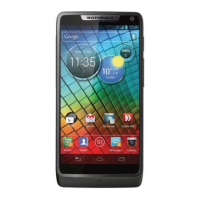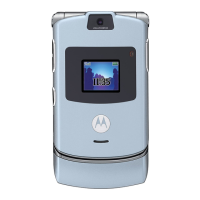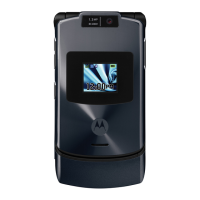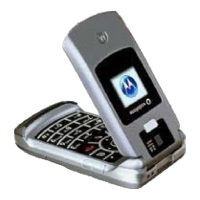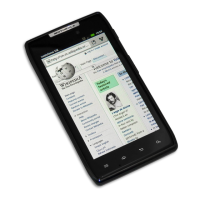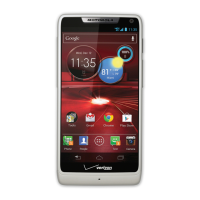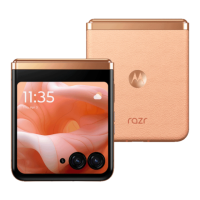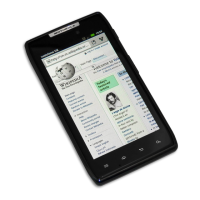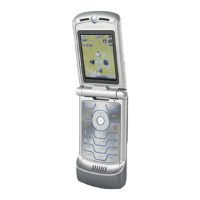Do you have a question about the Motorola razr and is the answer not in the manual?
| Panel type | AMOLED |
|---|---|
| Display diagonal | 4.3 \ |
| Touch technology | Multi-touch |
| Touchscreen type | Capacitive |
| Display resolution | 540 x 960 pixels |
| Ringer type | MP3 |
| Processor family | Intel |
| Processor frequency | 2 GHz |
| RAM capacity | 1 GB |
| Compatible memory cards | MicroSD (TransFlash) |
| Maximum memory card size | 32 GB |
| Internal storage capacity | 8 GB |
| Flash type | LED |
| Digital zoom | 4 x |
| Front camera type | Single camera |
| Maximum frame rate | 30 fps |
| Video recording modes | 1080p |
| Rear camera resolution (numeric) | 8 MP |
| Front camera resolution (numeric) | 0.3 MP |
| 2G standards | GSM |
| 3G standards | HSDPA, WCDMA |
| Wi-Fi standards | 802.11a, 802.11b, 802.11g |
| Bluetooth version | 2.1+EDR |
| 3G bands supported | 850, 900, 1900, 2100 MHz |
| Bluetooth profiles | A2DP, AVRCP, DID, HFP, HID, HSP, MAP, OPP, PBAP, SPP |
| SIM card capability | Single SIM |
| 2G bands (primary SIM) | 850, 900, 1800, 1900 MHz |
| Mobile network generation | 3G |
| FM radio | - |
| Audio formats supported | AAC, AAC+, AMR, eAAC+, MIDI, MP3, OGG, WAV, WMA |
| Image formats supported | BMP, GIF, JPG, PNG |
| Video formats supported | H.263, H.264, MPEG4 |
| USB connector type | Micro-USB B |
| Headphone connectivity | 3.5 mm |
| Form factor | Bar |
| Product color | White |
| Personal info management (PIM) | Alarm clock, Calculator, Calendar, Events reminder, Notes, To-do list |
| Subscription type | No subscription |
| Multimedia Messaging Service (MMS) | Multimedia Messaging Service (MMS) is a standard way to send messages that include multimedia content to and from a mobile phone over a cellular network |
| Platform | Android |
| App distribution platform | Google Play |
| Operating system installed | Android 4.1 |
| Battery capacity | 2000 mAh |
| Cables included | USB |
| Depth | 8.3 mm |
|---|---|
| Width | 60.9 mm |
| Height | 122.5 mm |
| Weight | 126 g |
Identify and understand the physical components and ports of your new phone.
Learn the procedure for inserting and removing the physical SIM card from your device.
Configure and manage settings for using two SIM cards simultaneously on your phone.
Configure your voicemail settings, including password and greeting, for incoming messages.
Configure personal and corporate email accounts to access your messages on the device.
Personalize your phone's look, sound, and basic setup for optimal user experience.
Discover the new features and improvements introduced with the Android 12 operating system.
Understand how to interact with the phone's external display for quick access.
Navigate and customize the phone's home screen layout, widgets, and shortcuts.
Learn how to interact with and customize the phone's lock screen for security and information.
Key concepts for navigating your phone and understanding basic functions for new users.
Understand the benefits and management of your Google account for phone services.
Interpret the meaning of various icons displayed in the phone's status bar.
Learn essential terminology related to phone functions, features, and operations.
Capture images of your phone's screen content using different methods.
Use voice commands to interact with your phone and access Google Assistant features.
Utilize Digital Wellbeing features to monitor and manage your phone usage habits.
Customize your phone's background image for the home and lock screens.
Personalize the app shortcuts displayed at the bottom of your home screen.
Add widgets for information, shortcuts for apps, and folders for organization.
Organize app icons, adjust their size, and manage notification dots on the home screen.
Change the phone's overall look and feel by installing and switching between launchers.
Configure settings for the phone's screen saver when idle on a dock or charger.
Manage running applications, including opening, closing, and switching between them.
Utilize split-screen and picture-in-picture modes to view multiple apps simultaneously.
Manage and understand how notifications appear on your phone's screen and status bar.
Explore the applications that come pre-installed on your phone and how to manage them.
Download new applications from the Play Store and keep existing ones updated.
Control which data and features apps can access by managing their permissions.
Remove installed applications or disable preloaded ones you don't need.
Troubleshoot issues caused by third-party apps by using the phone's safe mode.
Use Google Assistant and search widgets to find information on the internet.
Understand SMS, MMS, and group messaging, and learn to send and manage messages.
Set up and manage email accounts, read, send, and organize your messages.
Track upcoming events, manage reminders, and create new calendar entries.
Set alarms, use timers, and manage stopwatch functions for timekeeping.
Share, upload, and manage your photos and videos, including automatic backups.
Manage your phone's contacts, including adding, editing, and sorting them.
Handle incoming and outgoing calls, manage call settings, and troubleshoot call issues.
Listen to and manage your voicemail messages and mailbox settings.
Listen to music, transfer files, and connect MIDI devices for audio playback.
Turn Wi-Fi on/off, search for networks, and manage saved Wi-Fi connections.
Monitor and manage mobile data usage, set warnings, and restrict background data.
Set up and manage Wi-Fi hotspot and tethering options to share your phone's internet.
Turn Bluetooth on/off, pair devices, and manage connected Bluetooth accessories.
Set up and use NFC for secure contactless payments at checkout registers.
Share content securely with other devices using Quick Share and Bluetooth.
Transfer files between your phone and computer using a USB connection.
Mirror your phone's screen or cast media content to a compatible TV.
Set up and perform printing tasks directly from your phone.
Choose default applications for specific actions like opening links or browsing.
Control app access to usage data, unrestricted data, and other special phone features.
Manage app notification settings, including turning them on or off globally or per app.
Adjust notification volume, set default sounds, and customize sounds for specific apps.
Connect your phone to a charger and understand charging indicators and tips.
Optimize phone settings and activities to conserve battery power and extend usage time.
Activate Battery Saver to conserve power when the battery is low or automatically manage it.
Free up space by scanning for unused items or manually clearing cache and data.
Scan documents to Drive or save scans to home screen folders for easy access.
Use Do Not Disturb to mute calls, stop vibration, and block notifications.
Silence voice command replies and turn off screen reader or voice output features.
Set screen brightness manually or use Adaptive brightness for automatic adjustments.
Change the display to a dark background to reduce eye strain and save battery.
Configure apps to use the full screen display, stretching across the entire device.
Automatically change screen colors to warmer tones at night for easier viewing.
Configure accessibility features for visual, hearing, and dexterity assistance.
Magnify the screen using gestures or shortcuts for easier viewing of content.
Enable TalkBack to hear descriptions of screen elements and read text aloud.
Adjust timing controls and use external switches or keyboards for device interaction.
Set up buttons or gestures for quick access to essential accessibility features.
Configure security settings to protect your phone, apps, and personal data.
Set up patterns, PINs, passwords, or facial recognition for phone security.
Configure Smart Lock to keep your phone unlocked when connected to trusted devices.
Set up and use the fingerprint sensor for unlocking and secure authentication.
Keep a specific app in view until unpinned, preventing navigation to other screens.
Set up a SIM card lock using your carrier-provided PIN for added security.
Adjust app permissions at any time to control access to data and phone features.
Block or unblock mic and camera access for apps, either individually or for all apps.
Prevent others from viewing your pattern when you unlock your screen.
Manage phone location settings, control app access to location data, and review usage.
Set up emergency SOS and configure emergency information for first responders.
Add, manage, and remove Google and other types of accounts linked to your phone.
Configure automatic syncing for Google apps and manage sync options for other apps.
Adjust keyboard height, appearance, sounds, and typing features like glide typing.
Change the display language and add keyboard languages for multilingual input.
Enable AI features to learn app usage patterns and improve app opening speed.
Assign actions like opening Google Assistant or the camera to a double-press of the power button.
Choose between gesture navigation and 3-button navigation for moving between apps.
Enable one-handed mode to easily navigate your phone with a single thumb.
Configure the fingerprint sensor to open notifications and quick settings with a swipe.
Control the phone's flashlight using quick settings or a chopping motion gesture.
Use the Quick Capture gesture to instantly open the camera from any screen.
Customize settings for capturing screenshots, including gestures and editing options.
Back up apps, data, settings, and media to your Google account or Drive.
Set up user profiles, guest sessions, or screen pinning to share your phone securely.
Find and record your phone's unique IMEI number for warranty and security purposes.
Troubleshoot common hardware problems like slow performance or phone not turning on.
Understand reasons for phone heating and methods to keep it from overheating.
Troubleshoot issues related to random reboots, restarts, or unexpected shutdowns.
Resolve issues where the phone screen is unresponsive or stuck on a blank display.
Troubleshoot problems with making/receiving calls, signal strength, and SIM card recognition.
Troubleshoot issues related to not being able to make calls, no signal, or busy signals.
Resolve issues where the phone doesn't ring for incoming calls or the ring volume is low.
Troubleshoot problems like screen going black, dropped calls, or poor sound quality.
Troubleshoot charging problems and battery drain issues to improve battery life.
Identify causes for rapid battery drain and steps to extend battery life.
Troubleshoot connectivity problems with Bluetooth, Wi-Fi, and USB connections.
Resolve problems with connecting to Wi-Fi networks, connection drops, and hotspot issues.
Troubleshoot issues with USB connections for transferring files between phone and computer.
Troubleshoot problems related to forgotten unlock codes, Google sign-in, and account syncing.
Steps to recover or reset your phone's PIN, pattern, or password.
Troubleshoot problems with account syncing, including manual sync and connection issues.
Troubleshoot problems with apps, including crashes, updates, and general malfunctions.
Steps to resolve issues where apps are crashing, not opening, or not functioning correctly.
Troubleshoot problems related to blurry photos, deleted photos, and camera app errors.
Troubleshoot problems with sending/receiving messages, notifications, and app functionality.
Perform essential maintenance tasks like updating software and resetting network settings.
Check for and install the latest Android software updates for optimal performance.
Reset network settings to resolve connection issues with Wi-Fi, cellular, and Bluetooth.
Learn about factory resets and how to perform them from settings or externally.
Find resources for further assistance with billing, network, app, or phone issues.
